Leucism
Leucism (/ˈluːsɪzəm, -kɪz-/)[2][3][4] is a term used to describe a wide variety of conditions which result in the partial loss of pigmentation in an animal—which causes white, pale, or patchy coloration of the skin, hair, feathers, scales or cuticles, but not the eyes.[4] It is occasionally spelled leukism. Some genetic conditions that result in a "leucistic" appearance include piebaldism, Waardenburg syndrome, vitiligo, Chédiak–Higashi syndrome, and Melanophilin mutations. Pale patches of skin, feathers, or fur (often referred to as "depigmentation") can also result from injury.[5] As the term "leucism" is used to refer to conditions with a very wide range of unrelated causes it cannot be considered to be a single, specific condition.
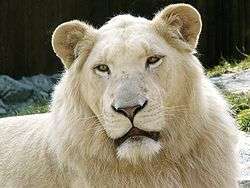
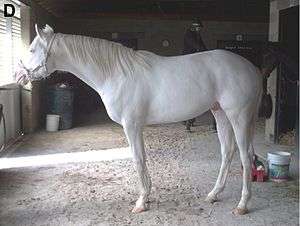
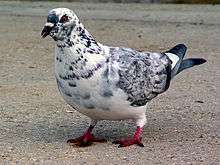
Details
'Leucism' is often used to describe the phenotype that results from defects in pigment cell differentiation and/or migration from the neural crest to skin, hair, or feathers during development. This results in either the entire surface (if all pigment cells fail to develop) or patches of body surface (if only a subset are defective) having a lack of cells that can make pigment.
Since all pigment cell-types differentiate from the same multipotent precursor cell-type, leucism can cause the reduction in all types of pigment. This is in contrast to albinism, for which leucism is often mistaken. Albinism results in the reduction of melanin production only, though the melanocyte (or melanophore) is still present. Thus in species that have other pigment cell-types, for example xanthophores, albinos are not entirely white, but instead display a pale yellow colour.
More common than a complete absence of pigment cells is localized or incomplete hypopigmentation, resulting in irregular patches of white on an animal that otherwise has normal colouring and patterning. This partial leucism is known as a "pied" or "piebald" effect; and the ratio of white to normal-coloured skin can vary considerably not only between generations, but between different offspring from the same parents, and even between members of the same litter. This is notable in horses, cows, cats, dogs, the urban crow[7] and the ball python[8] but is also found in many other species.
Due to the lack of melanin production in both the retinal pigmented epithelium (RPE) and iris, those affected by albinism sometimes have pink pupil due to the underlying blood vessels showing through. However, this is not always the case and many albino animals do not have pink pupils.[9] The common belief that all albinos have pink pupils results in many albinos being incorrectly labeled as 'leucistic'. The neural crest disorders that cause leucism do not result in pink pupils and therefore most leucistic animals have normally coloured eyes. This is because the melanocytes of the RPE do not derive from the neural crest. Instead, an out-pouching of the neural tube generates the optic cup that, in turn, forms the retina. As these cells are from an independent developmental origin, they are typically unaffected by the genetic cause of leucism.
Genes that, when mutated, can cause leucism include c-kit,[10] mitf[11] and EDNRB.[12]
Etymology
The terms leucistic and leucism are derived from medical terminology (leuc- + -ism). The stem leuc- is the Latin variant of leuk- from the Greek leukos meaning "white" (see Stedman’s, Dorland’s or Taber’s medical dictionaries).
Examples in nature
Leucism has been noted in a number of animal species, including:
- European hedgehog
- Kermode bear
- White buffalo
- Kenyan white giraffe
- Seneca white deer
- Leucistic giraffes in Kenya (14 December 2017)[13]
- White stag
- Moose[14]
- Killer whale
Examples in fiction and mythology
Gallery
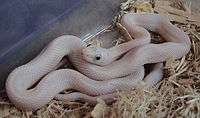 Leucistic Texas rat snake (Elaphe obsoleta)
Leucistic Texas rat snake (Elaphe obsoleta)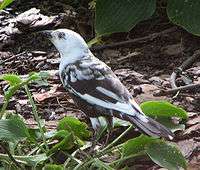 Leucistic common grackle (Quiscalus quiscula)
Leucistic common grackle (Quiscalus quiscula)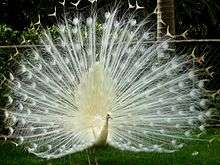 Leucistic Indian peacock (Pavo cristatus)
Leucistic Indian peacock (Pavo cristatus) Leucistic axolotls (Ambystoma mexicanum)
Leucistic axolotls (Ambystoma mexicanum)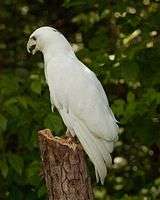 Leucistic red-tailed hawk (Buteo jamaicensis)
Leucistic red-tailed hawk (Buteo jamaicensis)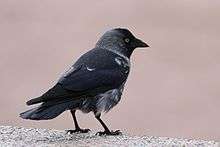
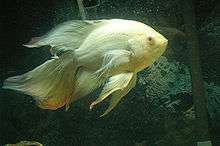 Leucistic long-finned oscar (Astronotus ocellatus)
Leucistic long-finned oscar (Astronotus ocellatus)- Leucistic American rhea (Rhea americana)
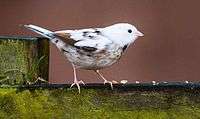 Leucistic reed bunting (Emberiza schoeniclus)
Leucistic reed bunting (Emberiza schoeniclus)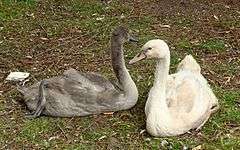 Leucistic mute swan cygnet (Cygnus olor) compared to a non-leucistic cygnet
Leucistic mute swan cygnet (Cygnus olor) compared to a non-leucistic cygnet_(24086649134).jpg) Leucistic squirrel
Leucistic squirrel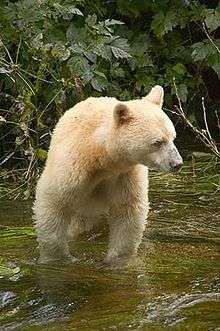 A Kermode (or spirit) bear is a leucistic American black bear. It is found only in the forests of British Columbia. It has a mutation in the gene for MC1R.[15]
A Kermode (or spirit) bear is a leucistic American black bear. It is found only in the forests of British Columbia. It has a mutation in the gene for MC1R.[15].jpg)
See also
- Albino and white squirrels
- Amelanism
- Dyschromia
- Erythrism
- Heterochromia iridum
- Melanism
- Piebaldism
- Vitiligo
- Xanthochromism
References
- Cho, Yun Sung; Hu, Li; Hou, Haolong; Lee, Hang; Xu, Jiaohui; Kwon, Soowhan; Oh, Sukhun; Kim, Hak-Min; Jho, Sungwoong; Kim, Sangsoo; Shin, Young-Ah (2013-09-17). "The tiger genome and comparative analysis with lion and snow leopard genomes". Nature Communications. 4 (1): 1–7. doi:10.1038/ncomms3433. ISSN 2041-1723.
- "leucistic". Oxford Dictionaries. Oxford University Press. Retrieved January 9, 2016.
- Merriam-Webster, Merriam-Webster's Unabridged Dictionary, Merriam-Webster.
- "leucism". The American Heritage Dictionary of the English Language (5th ed.). Boston: Houghton Mifflin Harcourt.
- "Depigmentation of Skin: Symptoms, Signs, Causes & Treatment". MedicineNet. Retrieved 2020-06-23.
- chemport.cas.org https://chemport.cas.org/cgi-bin/sdcgi?APP=ftslink&action=reflink&origin=npg&version=1.0&coi=1:CAS:528:DC%252BC3sXotlGksbg%253D&md5=1ee737efa06deefbbb993e3412a921a0. Retrieved 2020-06-23. Missing or empty
|title=(help) - White crows at Cornell University.
- Piebald ball pythons at Constrictors.com (archived 9 October 2006, from the original, accessed 18–22 July 2006).
- "Oculocutaneous Albinism". NORD (National Organization for Rare Disorders). Retrieved 2020-06-23.
- Coat colour, dominant white at Online Mendelian Inheritance in Animals.
- An L1 element intronic insertion in the black-eyed white (Mitf[mi-bw]) gene: the loss of a single Mitf isoform responsible for the pigmentary defect and inner ear deafness at Human Molecular Genetics.
- Waardenburg syndrome at Atlas of Genetics and Cytogenetics in Oncology and Haematology (archived 26 December 2005, from the original, accessed 18–22 July 2006).
- Johnson, Thomas (14 September 2017). "Rare white giraffes spotted in Kenya". Washington Post. Retrieved 31 December 2017.
- "Skogens vita konung (eng. "The White King of the Forest") - documentary tv programme". Swedish Television. Retrieved 9 June 2019.
- Ritland, Kermit; Newton, Craig; Marshall, H. Dawn (2001-09-18). "Inheritance and population structure of the white-phased "Kermode" black bear". Current Biology. 11 (18): 1468–1472. doi:10.1016/S0960-9822(01)00448-1. ISSN 0960-9822.
- Peters, Lucy; Humble, Emily; Kröcker, Nicole; Fuchs, Birgit; Forcada, Jaume; Hoffman, Joseph I. (2016-07-22). "Born blonde: a recessive loss‐of‐function mutation in the melanocortin 1 receptor is associated with cream coat coloration in Antarctic fur seals". Ecology and Evolution. 6 (16): 5705–5717. doi:10.1002/ece3.2290. ISSN 2045-7758. PMC 4983585. PMID 27547348.
External links
